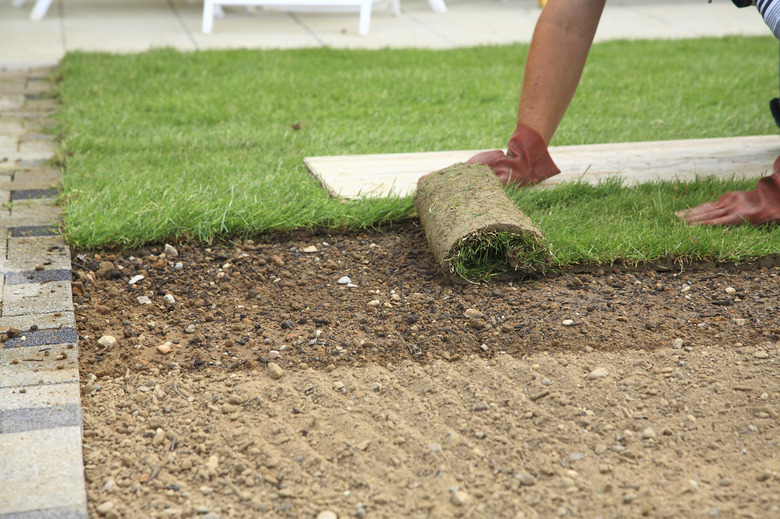How To Plant Sod In Arizona
Arizona presents a wide variety of climates to gardeners, from hot, dry deserts to high elevations with cold winters. Arizona's U.S. Department of Agriculture plant hardiness zones go from 4b through 10b. Sod planting details vary depending on where you live in Arizona and what kind of lawn you want.
Arizona presents a wide variety of climates to gardeners, from hot, dry deserts to high elevations with cold winters. Arizona's U.S. Department of Agriculture plant hardiness zones go from 4b through 10b. Sod planting details vary depending on where you live in Arizona and what kind of lawn you want. Choose sod varieties that tolerate your conditions, such as hot summers, high foot traffic, light requirements, grass texture and maintenance requirements.
Timing the Installation
Sod lawns can go in almost any time as compared to grass seed, which has limited favorable planting times. Avoid installing sod if the weather is hot and dry or very cold. In Arizona, this means periods of high temperatures and drought most likely to occur in desert areas during the summer before and after monsoons occur and harsh winter weather that can occur in mountainous or plateau areas. Well ahead of sod installation, choose the variety you want, calculate how many square foot you need and arrange for delivery as close to the installation time as possible.
- Arizona presents a wide variety of climates to gardeners, from hot, dry deserts to high elevations with cold winters.
- Sod lawns can go in almost any time as compared to grass seed, which has limited favorable planting times.
Choosing Varieties
In low to medium elevations of Arizona, which experience mild winters, bermudagrass (Cynodon dactylon), hardy to USDA zones 6 through 9, has wide use. It tolerates Arizona's intense sun and heat as well as salty or mineralized irrigation water but can be invasive. A number of varieties exist. Bermudagrass is brown and dormant in the winter but can be overseeded with annual cool-season grasses. For partially shaded lawns, coarser-textured St. Augustinegrass (Stenotaphrum secundatum) is suitable in USDA zones 8 through 11. At higher elevations with cold winters, Kentucky bluegrass sod (Poa pratensis), which grows in USDA zones 3 through 8, adapts well. Usually you can choose from several varieties, and sometimes blended sod of one or more varieties is available.
- In low to medium elevations of Arizona, which experience mild winters, bermudagrass (Cynodon dactylon), hardy to USDA zones 6 through 9, has wide use.
Preparing the Site
Before putting in sod, remove all old vegetation, rocks or debris and grade the site so there's a gradual slope of fertile soil away from houses or buildings and no sudden dips or low spots. Rake the soil surface so there's a fine texture for accepting the sod and encouraging good root growth. If the soil surface is soft so that sod could sink down into it, you may wish to use a roller to firm it. Ensure a moist planting bed by watering the soil a day or two before installation and letting the moisture even out.
Laying Sod
Once you receive the sod, keep it moist until planted. Much of Arizona has low relative humidity so unlaid sod needs frequent watering. Keep rolled sod in a shaded area and cover it with a loose material such as moist burlap. Lay the sod in staggered rows so the ends of rolls don't all occur at the same place, placing the length of the rolls along the length of the site. As you position the sod strips, allow the edges to downcurl slightly for a little extra room around the edges that helps the pieces join seamlessly as they grow. If sodding a slope, lay the sod lengthwise across the slope so it does not slip off and use landscaping pins to hold it in place. If needed, use a large sharp knife to cut the sod to fit the area being sodded. You can use the extra pieces to fill any gaps.
- Before putting in sod, remove all old vegetation, rocks or debris and grade the site so there's a gradual slope of fertile soil away from houses or buildings and no sudden dips or low spots.
- If the soil surface is soft so that sod could sink down into it, you may wish to use a roller to firm it.
Completing Planting
After the sod is down, go over it in two directions with a roller half-filled with water, which presses the sod firmly against the soil surface, evens it out and pushes the sod strips together so they don't dry out as quickly around the edges. For the first 10 to 14 days, water the sod frequently for a few minutes three to four times daily, with irrigations spaced during daylight rather than nighttime hours. Once the sod begins to root and is hard to pull up, water once each day for approximately 30 minutes. Then water every two to three days. Keep foot traffic to a minimum for approximately two to three weeks while the sod establishes itself in the site and do not mow during this time.
References
- U.S. Department of Agriculture: Plant Hardiness Zone Map
- University of Arizona Cooperative Extension Turf Tips: Sod Selection for Arizona Lawns
- Sunset: Planting a New Lawn
- University of Arizona Cooperative Extension: Master Gardener Manual Reference: Lawns: Planting
- University of Arizona Cooperative Extension Turf Tips: Vegetative Bermudagrass for Arizona Lawns
- Online Plant Guide: Stenotaphrum Secundatum/St. Augustinegrass
- Plants for a Future: Cynodon Dactylon – (L.) Pers.
- Online Plant Guide: Poa Pratensis/Kentucky Bluegrass
